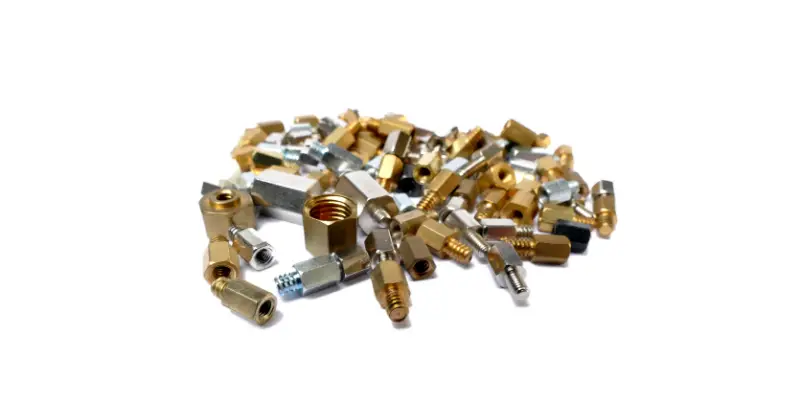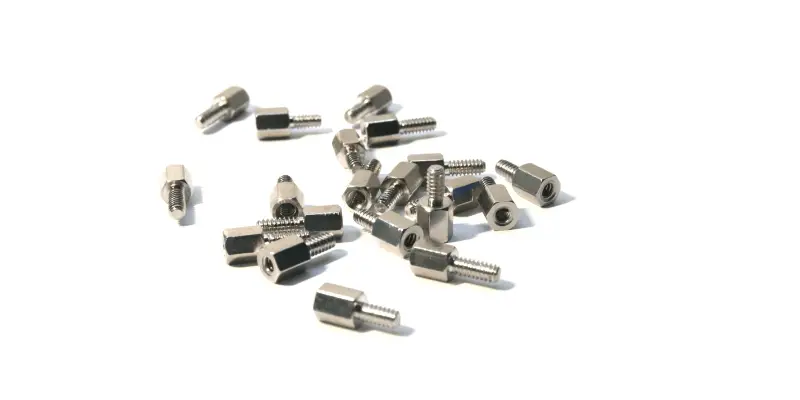Disclaimer: This post may contain affiliate links, meaning we get a small commission if you make a purchase through our links, at no cost to you. For more information, please visit our Disclaimer Page.
When you need to mount a motherboard to a surface, you need a standoff. But do you need all of them?
Typically, you need to attach as many standoffs in the case as there are mounting holes in the motherboard. You may get away by using one or two less as long as the motherboard does not touch the case at any place. But this is a risky strategy that may end up costing you a motherboard.
Table of Contents
What Is a Motherboard Standoff and What Is Its Purpose?
If you ever put together a desktop computer yourself, you will come across this piece of hardware. A motherboard standoff is a smallholder of sorts that looks like a metal screw. Usually, they are made out of metal or plastic.
Motherboards have multiple designated spots called mounting holes. When setting up the motherboard, you attach one side of these standoffs to the mounting holes and the other side attaches with the PC case. Doing so keeps the motherboard from touching the case in any place. Hence, the name of this equipment is “standoff” as it keeps different hardware apart.
And that name also gives away the purpose of this small tool. It prevents any unwanted connection between the motherboard and any other metallic surface, particularly the PC case.
A motherboard is essentially a large circuit board that connects different internal components of the computer and establishes a network. And when you attach the motherboard to a power supply, electricity surges through these tiny circuits and goes to different parts.
Now, it is important to keep the electricity contained within the pre-designed circuits. But if the motherboard touches any metal surface, the electricity will go all over the place, resulting in a phenomenon we call a short circuit.
Your computer’s casing is made up of metal that is very electrically conductive. So, if the motherboard ever touches the case, it will lead to multiple short circuits. So, it is absolutely vital that the motherboard never touches the case while the power is on.
And that is where the standoffs come in. They keep the motherboard, and by extension, all of its components, away from the metal casing.
Are Motherboard Standoffs Necessary?
Motherboard standoffs are indeed a necessary component when putting together any computer. These smallholders not only keep your motherboard attached to the PC case but also prevents any contact between the two.
Can You Install a Motherboard Without Standoffs?
Unless you plan on using a computer without any casing, you cannot install a motherboard without standoffs.
The PC case holds all the hardware in one compact place. And when you use a case, you need the standoffs for the motherboard.
Yes, the motherboard can get power and channel the electricity to different parts without the standoffs. And these parts are not necessary for the actual functioning of the motherboard. But you still need the standoffs to continue to run the computer in a safe and sustainable way.
And without standoffs, a motherboard will not be sustainable in the long term. Because an open motherboard will come into contact with other metal surfaces and that will lead to complications.
What Happens If You Do Not Use Motherboard Standoffs?
We have so far mentioned the importance of using standoffs when installing a motherboard. But what would happen if you do not?
The first risk you face is with the motherboard itself. The board is an intricately designed circuit board that carries electricity and data. And when this board comes into contact with the case when the power supply is on, all the different circuits will converge into one single point and burn up. This is called a short circuit.
This has the potential to permanently damage your motherboard as well as the attached CPU and other components. The damage may be visible on the outside or noticeable only when you try to turn the PC on. Regardless, using a motherboard without attaching the proper standoffs is a guaranteed way of ruining your computer.
The other potential concern is fire hazards. Short circuits are never a good thing, even when they are of a relatively small scale. And the short circuit in the motherboard could result in many of the parts getting fried or catching fire.
Do You Need All Standoffs for Motherboards?
Now you understand the importance of motherboard standoffs. But some of you may wonder whether to use all the standoffs that come with the case. After all, you can hang a picture on the wall without placing a nail on all four sides.
And yes, you can attach the case to the motherboard with a couple of standoffs less. The case will still stand and hold everything inside it. But you are effectively creating weak spots in your computer setups.
The motherboard and the case may very well come into contact with one another in these particular spots. And when they do and the power is running, it will cause damage to the motherboard.
So, you may operate your computer seemingly unaware of the risk. Then suddenly, your computer turns off and refuses to turn back on because the motherboard has been fried. So, take our advice and attach all the standoffs that come with the case in place. And make sure they are tightly in place.
Do the Standoffs Come with the Motherboard?
This is something that actually throws many people off. But the standoffs will not come with your motherboard proper. Rather, they are packaged with or built into the computer case.
Now, if they are pre-installed, then you will be limited as to the motherboards you can fit into these cases. Typically, these cases were made for a particular motherboard of a particular brand.
Fortunately, there are standards that most PC case follows. So, for instance, if you have standoffs designed for an ATX case, it will most likely work with any board in the ATX series.
Where Do You Get Motherboard Standoffs?
You usually get them as part of the package when you buy the entire computer or at least the case. If you want a fresh batch, you can go to the local hardware store to get more. Although it is best to contact the supplier that sold you the computer or case as they have a better chance of having the perfect match.
You can also check online platforms such as Amazon, AliExpress, Walmart, etc. for these parts. Make sure to read the description of the product and see if it matches the requirement for your particular PC case.
How Do You Install Motherboard Standoffs?
There are a few different types of motherboard standoffs out there. Some have a brass hex so, you will need a hex screwdriver to integrate. Other standoffs have a clip that you can snap into the tray.
Put the motherboard on top of the case tray and align the mounting holes with the standoffs. Then, with the help of the screw or clip, attach the screws through the standoffs one by one. It is best to start from the center mounting hole as that way you can keep the board from moving.
If the process seems too hard or the screws do not properly fit, you should consult with your supplier. You can even have a technician come in and properly attach all the standoffs for you. Remember to double-check the PC case after you have successfully installed the motherboard.
How Many Motherboard Standoffs Do You Need?
This will depend entirely on the configuration followed when making your specific motherboard and casing. Usually, ATX motherboards and cases require 9 standoffs in total.
Conclusion
Motherboard standoffs are there for a reason and it is in your best interest that you properly attach every single one of them. Otherwise, you will end up with a fried motherboard and be forced to buy another one.


